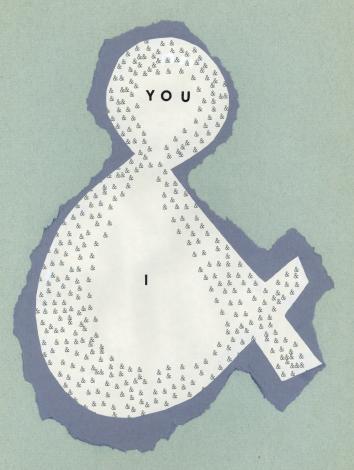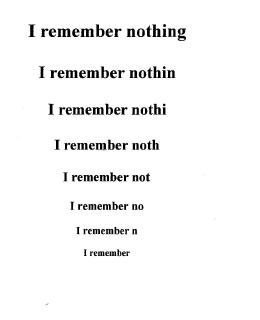| 阅读上一个主题 :: 阅读下一个主题 |
| 作者 |
留言 |
anna[星子安娜]
anna作品集
Site Admin

注册时间: 2004-05-02
帖子: 7141
|
 发表于: 星期日 四月 19, 2009 12:24 pm 发表主题: Concrete Poems by Paul 发表于: 星期日 四月 19, 2009 12:24 pm 发表主题: Concrete Poems by Paul |
 |
|
THE AMPERSAND
Two Concrete Poems By Paul Hartal


Concrete Poetry represents a hybrid genre that mediates between art and literature. I like its playful and imaginative possibilities, allowing creative experimentation with idea and form, image and text. Concrete poets communicate their message not only by means of sight patterns, but also by sound effects, or even by using the sensory capacities of touch, smell and taste.
I like to look at the world as a colossal verse made out of myriads of poetic subjects and objects. An airplane, for example, is a magnificent work of art. It also is a clamorous concrete poem, the flight of winged imagination roaring across the skies, dressed in plastic and metal. On a smaller scale, the roughly textured surface of an aesthetically designed vase emerges as a tactile and visual verse; and a bouquet of flowers as an olfactory and eye-pleasing delight of plant life. Even a gorgeous chocolate cake is a concrete ballad that celebrates hedonistic culinary triumphs, overruling the angst of weight watchers.
Philosophers are fond of the question of how real is real. From an ontological viewpoint concrete poems represent a step towards closing the gap between subject and object, idea and reality. Since art cannot exist without its idea, all art is conceptual. At the same time concrete poetry involves the notion that language possesses aesthetic attributes. Visual poems employ typographical elements and printed words as a graphic medium. Forming typographical units and words into particular shapes on a page adds greater meaning to the text and amplifies the statement. The visual design of the concrete poem embodies and extends the message beyond the meaning of its individual ingredients. The emerging piece evolves into a dual composition, both visual and literary. The whole becomes more than the sum total of its parts.
The roots of concrete poetry date back to antiquity. The Egyptians used pictographs or ideograms as a means of communication. More than two thousand years ago the Greek poet Simmias created a verse in the shape of an egg. In the 19th century Lewis Carroll used pictorial typography in the winding emblematic verse of The Mouse’s Tale, which is included in the story of Alice’s Adventures in Wonderland. Apollinaire’s Calligrammes, a collection of visual poems were published posthumously at the end of the First World War. As a movement, concrete poetry emerged in the 1950s. Its leading exponents included the Swiss Eugen Gomringer and the Brazilian Decio Pignatari.
I started to experiment with concrete poetry in the 1970s. I also suggested and helped to organize, along with the poet Tom Konyves, the first International Concrete Poetry Exhibition, as held in 1980 in Montreal. When Tom introduced my work through The Montreal Star, he illustrated his “Poetry Corner” article with my concrete poem, You and I (July 21, 1979). This opus has been published since then in various forums around the globe.
You and I is an anthropomorphic pattern poem designed in the shape of an ampersand (&). A typographical logogram, the ampersand represents the Latin word ‘et’, which means ‘and’. The symbol of this common uninflected conjunction originates in ancient Rome. About two thousand years ago the Romans started to use it by combining the alphabetic letters e and t that produce the ampersand. An array of small & symbols outline the humane figure, like a self-repeating mathematical pattern of fractals. The title of the work appears within the design; the “I” in the centre of the torso, while the word ‘You’, staring like eyes, creates eye contact with you, the viewer.
The opus exceeds the symbol. As a metaphor, You and I expresses in a novel way the ancient insight that individual existence does not end at the edge of our skin. It carries the premise that complete human independence is an illusion because we are all intimately interconnected, both to all other life on earth, as well as to the entirety of the universe.
The concrete poem I Remember Nothing is about process and transformation and the joy of playing with words. It also concerns itself with the mysterious miracle of memory. In this respect the work leads us to the magic door of the enigma of creation ex nihilo. The conundrum of creation ex nihilo, something rising out of nothing, never ceases to amaze me. It always fills me with a sense of wonder and awe.
Where do memories come from? You sit, for example, at school to write an exam. You are very nervous and struck by panic that you forgot everything that you learnt. But then slowly the gates of the storehouse of your memory open and your brain retrieves the chunks of knowledge you need in order to succeed in the exam.
When we are born we come to the world with a seemingly empty state of mind. We acquire knowledge as we grow and develop through the years, and accumulate our memories through the experience of a lifetime. However, life also involves constant change and entropy. Memories fade, remembrance erodes and recollections are forgotten.
Yet, memory also transcends the psychophysical framework, the mind-body set of the individual. The biological evolution of life has always been intertwined with psychological evolution. Jungian psychologists, for example, talk about a priori memories, archetypal patterns that are preserved in our psyche reflecting our evolutional history. Memories of geological eras, perhaps of eternity, are stored in the collective unconscious mind of humans. Thus, when we fly in a dream, it is a memory of a flight that we experienced perhaps on real wings many millions of years ago.
Montreal
April 2009
_________________
---------------------
Anna Yin
《爱的灯塔-星子安娜双语诗选》
<Nightlights> <Seven Nights with the Chinese Zodiac> ...
http://annapoetry.com
最后进行编辑的是 anna on 星期日 四月 19, 2009 12:29 pm, 总计第 2 次编辑 |
|
| 返回页首 |
|
 |
anna[星子安娜]
anna作品集
Site Admin

注册时间: 2004-05-02
帖子: 7141
|
 发表于: 星期日 四月 19, 2009 12:27 pm 发表主题: 发表于: 星期日 四月 19, 2009 12:27 pm 发表主题: |
 |
|
I was invited to read my poems in local library On Tuesday night.
Since I want to make the event interesting and educational, I plan to introduce another two poets' poems too. (Paul's concrete poems, and William Ma's three poems)
So I email to paul to ask permission and details about the two poems.
Thank him for his wonderful explanation.
Anna
_________________
---------------------
Anna Yin
《爱的灯塔-星子安娜双语诗选》
<Nightlights> <Seven Nights with the Chinese Zodiac> ...
http://annapoetry.com |
|
| 返回页首 |
|
 |
|
|
您不能发布新主题
您不能在这个论坛回复主题
您不能在这个论坛编辑自己的帖子
您不能在这个论坛删除自己的帖子
您不能在这个论坛发表投票
|
本论坛欢迎广大文学爱好者不拘一格地发表创作和评论.凡在网站发表的作品,即视为向《北美枫》丛书, 《诗歌榜》和《酷我电子杂志》投稿(暂无稿费, 请谅)。如果您的作品不想编入《北美枫》或《诗歌榜》或《酷我电子杂志》,请在发帖时注明。
作品版权归原作者.文责自负.作品的观点与<酷我-北美枫>网站无关.请勿用于商业,宗教和政治宣传.论坛上严禁人身攻击.管理员有权删除作品.
Powered by phpBB 2.0.8 © 2001, 2002 phpBB Group
phpBB 简体中文界面由 iCy-fLaME 更新翻译 |









